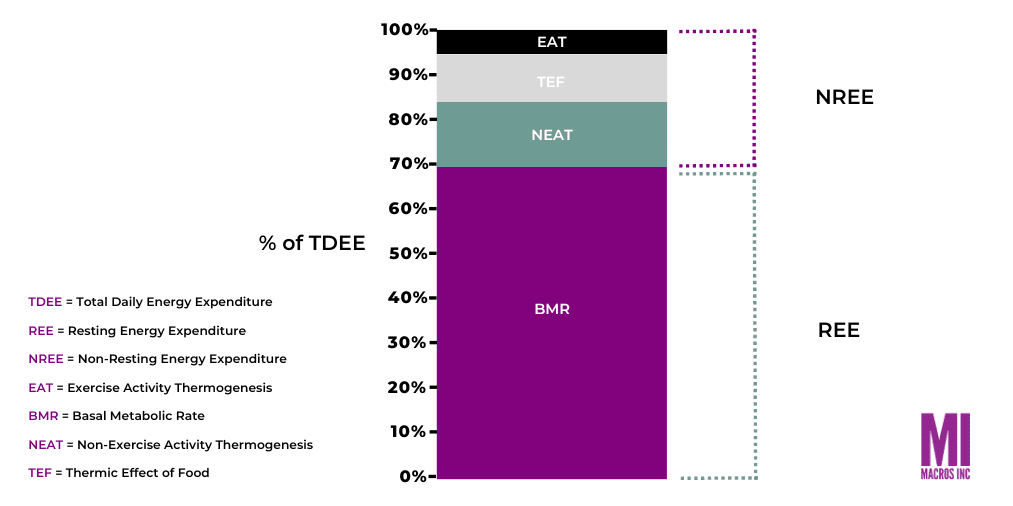To understand rapid fat loss, it’s crucial to grasp the underlying principles of fat loss. You’re likely familiar with the concept “calories in versus calories out” – meaning, for fat loss to occur, a calorie deficit must be established. Essentially, body fat is nothing but stored energy. To break it down, each pound of fat contains 3,500 calories, meaning you must have a 7,000-calorie deficit to shed 2 pounds of fat per week.
So, what does this translate to in real terms?
Jump to a Topic
How Your Body Loses Fat
Consider the following breakdown of how our body utilizes energy (calories) on a daily basis:

The bulk of our energy expenditure – around 65% – is attributed to our Basal Metabolic Rate (BMR), which is the energy required to keep us alive even if we were to remain completely inactive. Imagine lying in a hospital bed, not even engaging in the act of eating or digesting food – that’s your BMR.
Following this, there’s Non-Exercise Activity Thermogenesis (NEAT). This accounts for all daily movements not categorized as formal exercise, such as fidgeting, walking, or even the simple act of standing. NEAT constitutes approximately 20% of our daily energy consumption.
Lastly, there’s Exercise Activity Thermogenesis (EAT) and the Thermic Effect of Food (TEF), which are the calories expended during workouts and the energy spent digesting food, respectively. Given their relatively small contribution to daily energy use, we won’t delve deeply into them for this discussion.
How to Lose Two Pounds of Fat per Week
Imagine a 45-year-old woman who stands at 5’5″ and weighs 165 lbs. Using the Mifflin-St Jeor Equation, her BMR would be approximately 1,396 calories. This is the energy she’d need doing nothing all day. Factoring in her average daily movements and meals, we can add multipliers to this number.
Assuming she takes around 5,000 steps daily, her activity multiplier would be 1.375. This translates to maintenance calories of approximately 1,919 – let’s round it to 1,900 for simplicity.
For a goal of losing 2 lbs per week (or 8 lbs a month):
- Weekly maintenance: 1,900 x 7 = 13,300 calories
- Caloric deficit for 2 lbs: 3,500 x 2 = 7,000 calories
- Total weekly intake: 13,300 – 7,000 = 6,300 calories
- Daily intake: 6,300 ÷ 7 = 900 calories
900 calories a day is very restrictive, that’s not a lot of food. How can we get that number up and achieve that same goal?
Utilizing NEAT to Increase Your Calorie Burn
By increasing her daily steps to 12,000 (an additional 7,000 from the original count), and estimating that every additional 2,000 steps burns roughly 100 calories, her maintenance now rises to 2,270 calories per day.
Recomputing with this new data:
- Weekly maintenance: 2,270 x 7 = 15,890 calories
- Caloric deficit for 2 lbs: 7,000 calories (unchanged)
- Total weekly intake: 15,890 – 7,000 = 8,890 calories
- Daily intake: 8,890 ÷ 7 = 1,270 calories
While still challenging, this intake is slightly more manageable.
But let’s challenge our boundaries. Say she aims to lose 15 lbs in a month but can’t increase her steps. To achieve this, she would need an impossible deficit larger than her monthly calorie burn. Even a zero-calorie diet (which is medically unsafe and strongly discouraged) wouldn’t help her reach this target.
Thus, it’s essential to understand that rapid weight loss isn’t always feasible or healthy. A significant part of early weight loss is merely water weight, lost due to reduced glycogen.
Why Might Rapid Fat Loss Fail?
Aside from the numerical challenges, there are physiological and behavioral barriers. Severe calorie restrictions, or extreme dieting, often lead to increased hunger, causing unplanned and frequently untracked eating. This can sabotage the deficit. Furthermore, the body might conserve energy by inadvertently reducing NEAT, which further shrinks the calorie gap.
Even if weight loss is achieved quickly, without a sustainable change in habits, maintaining the reduced weight becomes a herculean task, often leading to rapid weight regain.
So, what’s the recommendation?
Aiming for a moderate calorie deficit is typically best. This translates to a weight loss rate of 0.5-1 lb per week. This approach not only facilitates sustainable weight loss but also imparts the necessary habits to maintain the new weight in the long run.
You can find out how to lose weight, the healthy way, in our full guide found here!
Try our nutrition coaching, for free!
Be the next success story. Over 30,000 have trusted Macros Inc to transform their health.
Simply fill out the form below to start your 14-day risk-free journey. Let's achieve your goals together!

